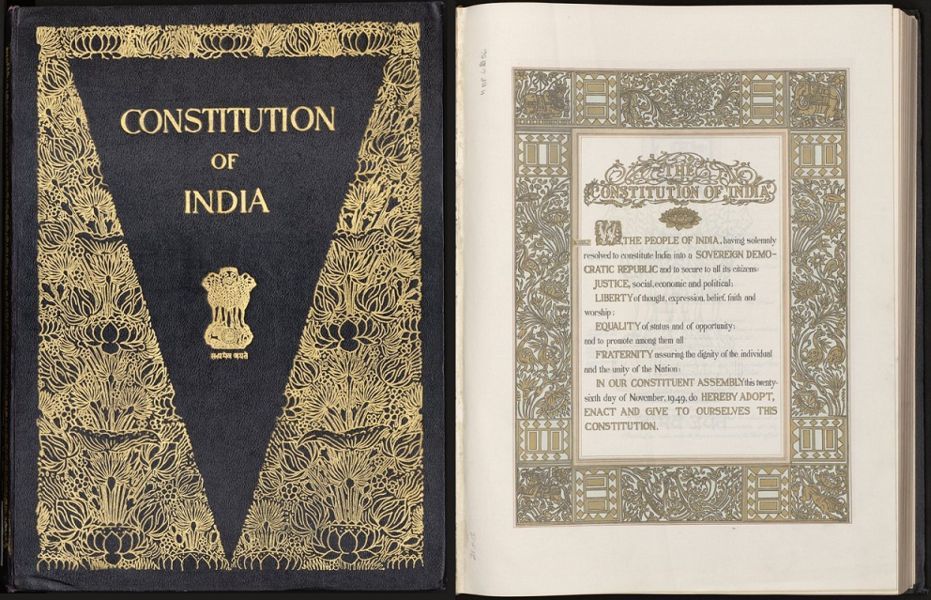3130007, Indian Constitution EBooks (IC) free pdf file & GTU related Indian Constitution syllabus V.S.bagad technical publication gtu book pdf download in single click.. You can also download free IC ( Indian Constitution) books PDF file and it's GTU related syllabus are also upload in this site.
| Sr. No. | Topics | Total Hours |
|---|---|---|
| 1 | Meaning of the constitution law and constitutionalism | 01 |
| 2 | History of Indian Constitution | 02 |
| 3 | Salient features and characteristics of the Constitution of India | 01 |
| 4 | Fundamental rights | 02 |
| 5 | Right to Equality under Article – 14 | 02 |
| 6 | Right to certain Freedom under Article 19 | 02 |
| 7 | Scope of the Right to Life and Personal Liberty under Article 21 | 02 |
| 8 | Fundamental Duties and its legal status | 02 |
| 9 | The Directive Principles of State Policy – Its importance and implementation | 02 |
| 10 | Federal structure and distribution of legislative and financial powers between the Union and the States | 03 |
| 11 | Parliamentary Form of Government in India – The constitution powers and status of the President of India | 02 |
| 12 | Powers and Procedure for Amendments in Indian Constitution | 01 |
| 13 | History of amendments in Indian Constitutional | 0 |
| 14 | Emergency Provisions : National Emergency, President Rule, Financial Emergency | 03 |
| 15 | Local Self Government – Constitutional Scheme in India | 03 |
Course Outcomes:
| Sr. No. | CO statement | Marks % weightage |
|---|---|---|
| CO-1 | Enhance human values , create awareness about law enactment and importance of Consitution | 10% |
| CO-2 | To Understand the Fundamental Rights and Fundamental Duties of the Indian Citizen to instill morality, social values, honesty, dignity of life and their social Responsbilities. | 30% |
| CO-3 | Create Awareness of their Surroundings, Society, Social problems and their sutaible solutions while keeping rights and duties of the citizen keeping in mind. | 20% |
| CO-4 | Understand distribution of powers and functions of Local Self Government. | 20% |
| CO-5 | Understand the National Emergency, Financial Emergency and their impact on Economy of the country. | 20% |
The Constitution of India is the
supreme law of India. It frames fundamental political principles, procedures,
practices, rights, powers, and duties of the government. It imparts
constitutional supremacy and not parliamentary supremacy, as it is not created
by the Parliament but, by a constituent assembly, and adopted by its people,
with a declaration in its preamble. Parliament cannot override it.
The world’s longest constitution is the
Indian’s constitution. At its commencement, it had 395 articles in 22 parts and
8 schedules. It consists of approximately 145,000 words, making it the second
largest active constitution in the world. Currently, it has a preamble, 25
parts with 12 schedules, 5 appendices, 448 articles, and 101amendments
“set of rules how
state(country) will be ruled.”
A constitution is primarily a set of rules and
principles specifying how a country should be governed, how power is
distributed and controlled, and what rights citizens possess.
It is usually written down and
contained within a single document; the UK is unusual in having an uncodified
constitution with many sources.
Time Line of Formation of "The Constitution of India
The time period taken to prepare Indian Constitution is 2 year, 11 months, 18 days. Indian Constitution was signed by members of Constitution assembly on January 24, 1950.
· 6 December 1946: Formation of the Constitution Assembly. (in accordance with French practice.)
· 9 December 1946: The first meeting was held in the constitution hall (now the Central Hall of Parliament House). 1st person to address J.B. kripalani. Temporary president Appointed - Sachchidanandsinha. (Demanding a separate state, the Muslim League boycotted the meeting.)
· 11 December 1946: President Appointed - Rajendra Prasad, vice- Chairman H. C. Mukherjee and constitutional legal adviser B. N. Rau (initially 389 members in total, which declined to 299 after partition. out of 389 - 292 were from govt. province, 4 from chief commissioner province and 93 from princely states)
· 13 December 1946: An 'Objective Resolution' was presented by Jawaharlal Nehru, laying down the underlying principles of the constitution. which later became the Preamble of the constitution.
· 22 January 1947: Objective resolution unanimously adopted.
· 22 July 1947: National flag adopted.
· 15 August 1947: Achieved independence. India Split into Dominion of India and Dominion of Pakistan.
· 29 August 1947: Drafting Committee appointed with Dr. B. R. Ambedkar as the Chairman other 6 members of committee was : Munshi, MuhammedSadulla, Allad Krishna swami ayyar, Gopala swami Ayyankar, Khaitan, Mitter
· 16 July 1948: Along with HarendraCoomarMookerjee V. T. Krishnamachari was also elected as second vice-president of Constituent Assembly.
· 26 November 1949: 'Constitution of India' passed and adopted by the assembly.
· 24 January 1950: Last meeting of Constituent Assembly. 'constitution of india' all signed and accepted. (with 395 Articles, 8 Schedules, 22 Parts)



Comments
Post a Comment